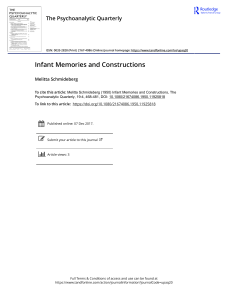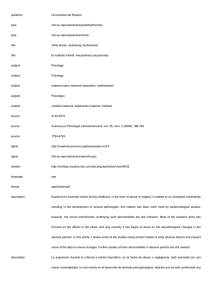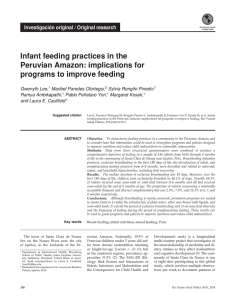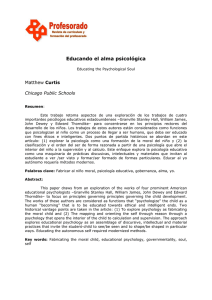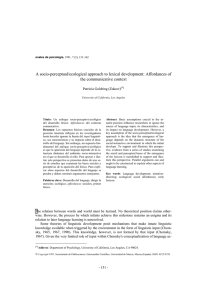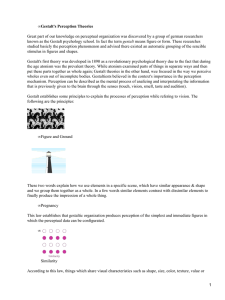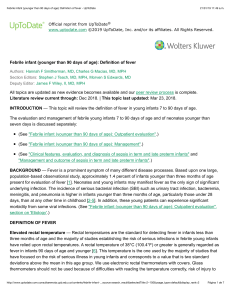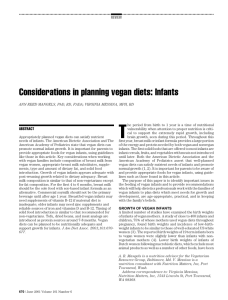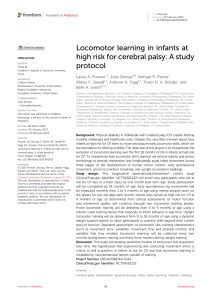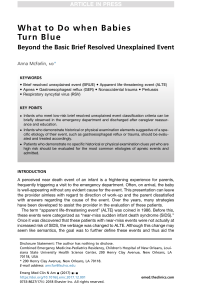Early language development from a personal perspective
Anuncio
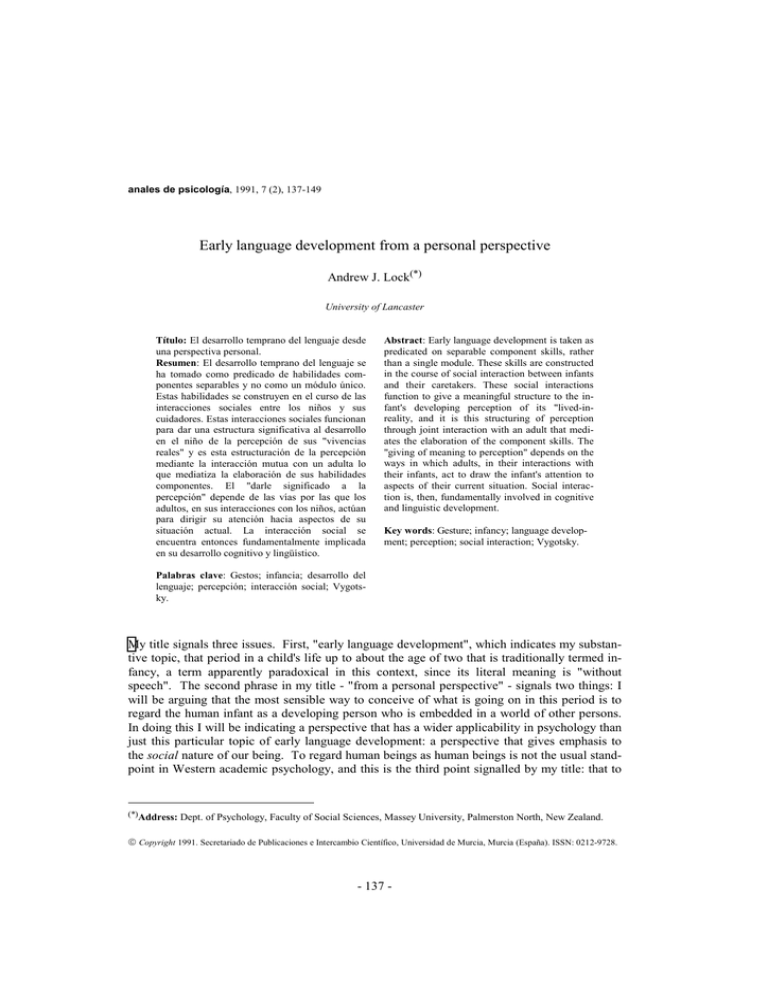
anales de psicología, 1991, 7 (2), 137-149 Early language development from a personal perspective Andrew J. Lock(*) University of Lancaster Título: El desarrollo temprano del lenguaje desde una perspectiva personal. Resumen: El desarrollo temprano del lenguaje se ha tomado como predicado de habilidades componentes separables y no como un módulo único. Estas habilidades se construyen en el curso de las interacciones sociales entre los niños y sus cuidadores. Estas interacciones sociales funcionan para dar una estructura significativa al desarrollo en el niño de la percepción de sus "vivencias reales" y es esta estructuración de la percepción mediante la interacción mutua con un adulta lo que mediatiza la elaboración de sus habilidades componentes. El "darle significado a la percepción" depende de las vías por las que los adultos, en sus interacciones con los niños, actúan para dirigir su atención hacia aspectos de su situación actual. La interacción social se encuentra entonces fundamentalmente implicada en su desarrollo cognitivo y lingüístico. Abstract: Early language development is taken as predicated on separable component skills, rather than a single module. These skills are constructed in the course of social interaction between infants and their caretakers. These social interactions function to give a meaningful structure to the infant's developing perception of its "lived-inreality, and it is this structuring of perception through joint interaction with an adult that mediates the elaboration of the component skills. The "giving of meaning to perception" depends on the ways in which adults, in their interactions with their infants, act to draw the infant's attention to aspects of their current situation. Social interaction is, then, fundamentally involved in cognitive and linguistic development. Key words: Gesture; infancy; language development; perception; social interaction; Vygotsky. Palabras clave: Gestos; infancia; desarrollo del lenguaje; percepción; interacción social; Vygotsky. My title signals three issues. First, "early language development", which indicates my substantive topic, that period in a child's life up to about the age of two that is traditionally termed infancy, a term apparently paradoxical in this context, since its literal meaning is "without speech". The second phrase in my title - "from a personal perspective" - signals two things: I will be arguing that the most sensible way to conceive of what is going on in this period is to regard the human infant as a developing person who is embedded in a world of other persons. In doing this I will be indicating a perspective that has a wider applicability in psychology than just this particular topic of early language development: a perspective that gives emphasis to the social nature of our being. To regard human beings as human beings is not the usual standpoint in Western academic psychology, and this is the third point signalled by my title: that to (*)Address: Dept. of Psychology, Faculty of Social Sciences, Massey University, Palmerston North, New Zealand. Copyright 1991. Secretariado de Publicaciones e Intercambio Científico, Universidad de Murcia, Murcia (España). ISSN: 0212-9728. - 137 - 138 Andrew J. Lock an extent what I say should be regarded as a personal view rather than a review of work from more common paradigms. The conception of infancy I am putting forward here has been stated more eloquently by the theologian John Macmurray in his Gifford lecture at the University of Glasgow in 1954: he is..."adapted", to speak paradoxically, to being unadapted, "adapted" to a complete dependence upon an adult human being...He is born into a love-relationship which is inherently personal. Not merely his personal development, but his very survival depends upon the maintaining of this relation; he depends for his existence...upon intelligent understanding, upon rational foresight. He cannot think for himself, yet he cannot do without thinking; so someone else must think for him...He cannot do himself what is necessary to his own survival and development. It must be done for him by another who can, or he will die (1961:48). The unit for analysing human development, in Macmurray's view, is not the "I", the detached, passive "I" of the Cartesian slogan "I think, therefore I am", but the "You and I", out of whose relation we actively construct ourselves and our world. A more neutral statement of this view, and thus one that has a wider applicability in that it does not connote an emotional structuring of the adult-infant relationship in such contemporary Western historical terms, underpins the work of the Russian psychologist, Lev Semenovitch Vygotsky: Every function in the child's cultural development appears twice: first, on the social level, and later on the individual level; first, between people (interpsychological), and then inside the child (intrapsychological). This applies equally to voluntary attention, to logical memory, and to the formation of concepts. All the higher functions originate as actual relations between human individuals. Vygotsky (1978:57) I am going to very briefly outline one psychological theory of this stage in development that comes from a much more "individualistic" perspective, put forward by Elizabeth Bates and her colleagues, since it will provide a "handle' for me later on. What Bates and her colleagues have done is take a plethora of developmental measures on a cohort of infants, and then look for the patterns of relationships that emerge between them, both at one age, and prospectively from one stage of development to a later one. This analysis yields a picture of what developments go with each other, and what early abilities might form the basis for the achievement of later ones. From this tactic, some of the traditional measures of infant development - their ability to find hidden objects, for example, emerge as showing no relation to the infant's subsequent development of language abilities -whereas others - such as the ability to use one object to do something to another object - tool-use - do show strong developmental affinities to later language emergence. The crux of their argument is that there are three separable sets of measures, separable in the sense that they do not show developmental relationships between themselves, that feed in to the establishment of language. These measures are reflective of underlying abilities that comprise the essential skills an infant deploys to build language from: the skills are gestural communication, as measured by the child's developing ability to use gestures such as pointing; means-end analysis, the ability to break down problems into their components, re-arrange or substitute different components, and thus solve particular forms of problems (with this skill being indexed by the infant's developing ability to use tools); and finally, an imitative capability, being able to reproduce complete activities without necessarily analyzing them down into their component parts. We are thus confronted with a more developmental, constructive view of the foundations of language development than the innateist view argued for by many linguists. This view is essentially similar to that which dominates in linguistically-sourced theorizing, particularly that associated with the work of Chomsky, in that both portray human children as anales de psicología, 1991, 7(2) Early language development from a personal perspective 139 objective, disembodied problem solvers; that what we see them doing is just a "front" for the exercise of structural principles of one sort or another. Children are being portrayed here as marionettes who receive information from their senses about the state of the world, process that information by filtering it through some very complicated pin-ball machine that constitutes their "mind", then they move their bodies in obeyance with their "score", and eventually modify the structural principles of the pin-ball machine on the basis of the feedback information they get as to what happens next. All that differs is the source of the structuring principles: on the one hand, these are seen as innately given, and the social world is just another source of data; on the other, they are cognitively constructed, but again, the social world is just another source of data that is set apart from the child, on which the child "operates". In contrast to these traditional approaches just sketched, I am going to go on to argue that we need to regard children instead as embodied agents immersed in activities, engaged with other already-enculturated agents, and that much of the rhetoric that has guided research into language development has to be recognized as just that. It is predicated on an inappropriate perspective that jettisons the reality of being a human actor in favour of an objectively defined model. The main point I will be developing is that human development has the essential social and human characteristic emphasised by writers such as Macmurray, Mead and Vygotsky, and that in the particular context in which I am talking here, the sorts of skills that might underwrite language development have a foundation in the social transactions that occur between practised adults and novitiate infants. Let me begin this task by looking at some things 12 month old infants are able to do. All three illustrative examples indicate this 12 month old understands that other people are integral to the successful realization of her intentions. Her yelling is to get another's attention, and once she has it, she is able to direct it. In two instances she does this by pointing; in the third by using the object involved in her goal as a prop. Note that in this last example she is using her beaker as an adult might use a word like "more": the beaker is used in the manner of a symbol, to refer to something "beyond itself". In addition, and in all three cases, she co-ordinates two separate parts of her body together in realizing her goal: she uses both her voice and her hands in communicating, and this conjunction is important in getting across to the other person what she is on about. Yelling on its own, as any parent will tell you, is very difficult to do anything about: so, likewise, on their own, are pointing or waving beakers. Yelling certainly conveys that something is up, but is frustratingly vague; pointing, on its own, conveys perhaps an interest on the child's part in an object or event, but leaves one as an adult with little room for manoeuvre other than to say, "Yes, that's an apple", or to ignore it entirely; and waving objects around is so commonplace that it would most likely go unremarked. Infants under 12 months of age only haphazardly combine activities for the purpose of communicating. From 12 months onward such performances become more common, and more actions can be combined. For example, one 14 month old tea-addict yelled immediately his mother brought the tea-tray in one afternoon, pointed to the cups, looked at his mother, and smacked his lips. What is remarkable about this gestural communication ability, one that all parents will recognize as a quite normal ability for infants of this age, is that, until about 15 years ago, it attracted almost no interest from developmental psychologists. Even now, it is only the rare textbook that gives it passing mention. Part of the reason for this is that most developmental psychology is done in laboratory situations, using the experimental model as its main tool of investigation. Under these conditions, the investigator's attention is generally on his or her technolanales de psicología, 1991, 7(2) 140 Andrew J. Lock ogy, and the infant's activities only count where they are deemed relevant to the test at hand. Another reason is the lack of theoretical interest this pantomiming might have for a respectable academic, for, a priori, it has been ruled out of having anything to do with subsequent language development, for language is a unique phenomenon, and "it is senseless to raise the problem" of what these early abilities might have to do with it. Figure 1: Unable to reach a beaker, a 12 month-old infant "yells" to attract attention, and once she has it, indicates the object she wants with an outstretched hand. The real problem, then, is to show how what is going on at this point, what led up to it, and what subsequently happens, tie in with becoming able to talk. The general framework within anales de psicología, 1991, 7(2) 141 Early language development from a personal perspective which what follows is embedded is shown in Figure 4. My view of this period of development is a continuity one. Early "words" are the vocal counterparts of earlier non-vocal gestures. We need to beware seeing them, to begin with, as something special, called "language", just because they sound like language, but as part-and-parcel of a communicative efflorescence that goes back to the earliest points of the infant's life. Figure 2: Unable to reach an apple, the same infant yells to attract attention, and then directs it with a point. In the earliest stages of their lives, human infants behave in ways that suggest they know very little about their situation in the world, their needs, what they want, and so on. We may assume they have some subjective experience of the world and their bodily existence in it, and also that the irritability they show to us is accompanied by changes in the quality of their subjective experience. This is an assumption, but I would argue it is a reasonable one. Certainly, outside of the scientific arena, in the realm of practical affairs, it is not only a reasonable assumption but an actual one made by all parents. That is, if we as "real live adults" did not work from this assumption, then there would be no such thing as human development, for, in practical terms, human development is predicated on the fact that adults treat infants as if they were human beings. Can we assume anything else? We could, but I think we get into very difficult waters if we do. So, without assuming anything else, can we say anything more about how an infant might feel when it cries, for example. What does an infant mean by crying? Could we give an English interpretation of crying? I think the safest thing we can say is that the infant is uncomfortable: and nothing more. It doesn't know what sort of discomfort it is; what causes it; what might make it go away; even that it is possible for it to go away. Let me, then, for the sake of argument, gloss this discomfort in English as: 1. (WHATEVER THIS IS I DO NOT WANT IT) anales de psicología, 1991, 7(2) 142 Andrew J. Lock Now, we can ask, using the evolutionary analogy already introduced, what sorts of implications follow from this position. Fortunately for our existence, one implication clearly does follow: 2. (I DO WANT SOMETHING OTHER THAN THIS) We can call it "THAT". So, 3. (I DO WANT THAT) anales de psicología, 1991, 7(2) Early language development from a personal perspective 143 (And once we know what THAT is, we have changed the subjective value of our initial discomfort into something a bit more specific; we have a more precise knowledge of WHATEVER THIS IS; it's what is negated by THAT). But human infants are exceptionally immature at birth, and have very few individual skills that enable them to satisfy their needs on their own. Thus (I DO WANT THAT) also brings with it the implication (YOU DO SOMETHING). This analysis can very quickly get very complex from here, so I will simplify things. Accept that from the starting point we have a set of implications that follow on, in an analogous manner to the possible niches that follow on for the evolutionary trajectory of bats that is entailed by the existence of moths. Infants give us evidence that they realize these implications in the course of their first year of life. Thus, for example, 2 month-old infants generally begin to cease crying when they see their mothers unbuttoning themselves for a feed. They now know THAT is what they want. But it is not until about 9 months that they give us evidence that they have mastered the implication YOU DO THAT, for it is not until this age that they begin to direct their crying at adults, thus indicating a coming to grips with the realization of the instrumentality of another's agency in attaining their own, now partly specified, goals. This early stage of development is one, then, in which a chain of implications is gradually given an explicit rendering in the infant's knowledge. But while infants are now controlling this implication, they are not making the separate components of this "message" explicit. The "meanings" of early communication are undifferentiated, holistic "chunks", in which the separate components (separate from the talking, enculturated adult's perspective, that is) have yet to be distinguished from each other: YOU (the agent) from DO (your action) from THAT (the object or result of your action). Again, as with gesture, it is possible to cast the infant's task in terms of an implicational series that stems out from the early capabilities. Infants have to make a remarkable transformation in the basis of their knowing and perceiving to get to language proper. To begin with, they are concerned with themselves and their relationship to the "here-and-now". By contrast, language is based more in a concern for the atemporal relationship between one object and another. As an infant, for example, I could deal with the fact that the Overhead Projector is to my right: as a language user I have to cope with something that an infant can't; that the Overhead Projector is to the right of the door. It is possible to spell out an another implicational sequence that would result in a shift from implicit, egocentric coding to explicit, allocentric coding, a shift that is part and parcel of constructing the simple propositional forms that characterize the early emegence of language proper: however, given present constraints, I am not going to go into any details here. At this point there are two questions we need ask. First, what is this development of knowledge doing for the baby? And second, where do adults fit in to the picture? With respect to the first question, I suggest that the infant's growing knowledge is having its effect in informing the infant's perception, through imbuing what is perceived at any particular moment with a meaning that has its origin in another place and time, a meaning that is not given in the instantaneous act of perceiving. What I mean by this is that infants come to see the world differently because what they perceive is imbued by meanings that have been established at other times: there is an incorporation of these other times into the present. This is difficult to put in words, so let me do it visually. This is a classic random dot pattern that psychologists are fond of. Actually, it shows a dalmation dog. Once you have been told that, your immediate perception of the dots changes: you can't help but see the dog, nor imagine how you couldn't see it before. Your imanales de psicología, 1991, 7(2) 144 Andrew J. Lock mediate perception of the dog is being structured by information from a time other than the one you are immediately in. That time was only a few seconds ago, when I told you about it. In this vignette, "I" have been playing the role of a "parent" to you: the same role, I suggest, that parents play for infants. Parents live in a culturally-constituted perceptual world, a world in which many implicational "niches" for knowledge have been worked out and conserved, and which structure their perception. Unlike the situation of our poor, original bat, the future possibilities for our "form" of life are not strung out as implied possibilities across aeons of time. Rather, our possible niches have been realized as "forms" of life during our cultural histories, and are actually present in our immediate world, informing our adult perceptions and actions, and these include our perceptions of, and actions towards, our infants. In acting with and towards infants, then, we can provide them with "short-cuts" in the re-creation of their form of life, in that we can import into their perception a structure that is the explicit realization of a chain of implications confronting the infant, such that the infant is not left to his or her own devices, having to figure out the whole historically-generated form of life he or she needs to attain on his or her own. Figure 5: Perceptual problem solving: first you don't see it, then you do, and can't not see it. This is getting quite abstract again, so let me bring it more round to the concrete with a few examples. First with respect to time and perception. I can illustrate the point by showing you an example of an interaction between an 18 month-old infant and his mother in which they interact in the realm of their shared imagination. During this interaction, mother hands the infant anales de psicología, 1991, 7(2) Early language development from a personal perspective 145 an empty cup, and says, "Go on, give Teddy a drink". The infant proceeds to raise the cup to Teddy's lips. There are riches to be mined out of this interchange, but here I want to take just one point. This interchange is only possible because neither mother nor child acts on the basis of what they objectively see. The cup is actually empty, but it is acted on by both of them as if it were full. The immediate situation only makes sense if we accept that the cup is perceived by the infant in the light of what he knows from other times and places. The same is true of those marks sewn in near Teddy's chin, for Teddy really has no mouth. The episode is impossible unless both participants perceive something other than what is in front of them. During the rest of this interaction the mother evidences a concern to make these temporal links between her infant's perception and knowledge through using her language to "hop" from present context and time to other contexts and times, thereby importing different values into their shared perception of objects. For example, when winding up a clockwork toy she says: "Oh look, its got a key like the clock at home"; looking at a picture in a book, "Can you see his shoes? They're like daddy's, aren't they"; and "Look, a red car, like the one we saw at the garage this morning". Secondly, in the way in which she interacts with her infant, she places a lot of emphasis on isolating parts from wholes, and then recombining parts into new wholes. In doing this she is again changing the value of the object in question in her infant's perception. Just following her dialogue when looking at a picture book illustrates this: It's a hen. There's a beak. And two feet. And there's a hen with lots of little chicks. There's a tree. And how many leaves have you got on the tree? One, two, three.....sixteen leaves and sixteen little birds sitting on the branch. And look at these little birds here. There are two big ones, and there are two more big ones, and there are two very big ones and there's some little ones and they've got.., do you see where they're eyes are? Do you? Where's the birdy's eye? Look at the hen, look it has separable parts, beaks and eyes; trees have leaves and branches, and each one can be counted in relation to the others. Things go together: hens and chicks; birds and branches. Things vary in relation to abstract standards: they can be big, very big, little, and so on. In other parts of the interaction we can pick up on the mother going further along these lines. Parts can be in particular relations to each other: Look what the tractor's got on top of it. He's got some sand in his truck. What's he got on his foot there? Show it to Teddy. Put it on the saucer. Put that bug into the bucket. Are you going to get the snake to catch this bubble? anales de psicología, 1991, 7(2) 146 Andrew J. Lock By no means all parents act like this particular mother, and it is the variation between parents that serves to highlight the role of adults in structuring their infants' perceptions of the world. Consider, for example, how infants get themselves picked up, by raising both their arms up to an adult. How do infants develop this particular gesture? There are at least two routes to this gesture: one originates in social interaction, the other in direct action on the infant's part. Typically, adults pick up an infant in one of two ways, and which particular way they do it seems typical of each particular adult. In addition, how an adult picks up an infant is related to other characteristics of their acting in a number of different situations. The first sort of pick up I will term the "marked" form. The adult attracts the infant's attention; extends their own hands out (demonstrate); holds his or her gesture, and says something like "Do you want to come up?"; and generally waits for some signalling of compliance on the infant's part, by a perceptible moving of the arms to accommodate the adult's hands (and here I'm short circuiting my description by ignoring how the infant got as far as this stage in assisting in the interaction); and then the infant is lifted, and something like "And now you can come and see Teddy" is said to them. Thus the adult structures the interaction into its component parts, and clearly signals these to the infant: get attention; indicate the pick up; comment on the reason. This marking strategy shows up in other aspects of the parents' activities. When playing with toys they only select a few, but spend a deal of time interacting around them, and show when they do so a concern for relationships between parts and wholes. They direct the child's attention to parts of objects, and they arrange objects into some sort of relationship with each other: a horse, for example, may be placed to stand with its two front legs on a block, or made to jump over the block, and so on. They use more first and second person singular pronouns "I" and "You" - in their speech than first person plural ones - "We" - suggesting that they have a clearly articulated perception of themselves and their infants as separate parts of each other's worlds. They also use quite short and simple language to the infant, indicating they are adjusting what they say to their perceived level of the infant's individual abilities. Infants dealt with in this manner tend to take their adjustive arm-raising out of the pick up situation and use it as a request to be picked up between 9 and 12 months of age. By contrast, there is an unmarked style. In the pick up the infant is "swooped" on with little warning: "Let's go and see Teddy". Object play is characterized by giving the infant an object and sitting back. The infant explores the object alone, and is given another object when they get bored. The pronoun "We" predominates over "I' and "You"; and longer utterances are directed to the infant. In sum, the adult shows less concern with breaking the world down into its constituent parts, and articulating the separateness and possible inter-relations of particular parts and wholes. Infants interacted with thus tend not to raise their arms to request being picked up until after 14 months of age, and they get the gesture, not from the social act of being picked up, but from their own direct acts of pulling themselves up onto their feet by grabbing hold of something above their heads. They get there in the end, but they get there more slowly, because they are not getting as much in the way of clues as to how parts of their own activities mesh in with the world; nor are they getting as articulated a world being transacted to them in the course of their interactions with those significant adults who mediate their perception. With respect to early language, evidence is emerging that these forms of social interaction are instrumental in the way in which an infant goes about the task of constructing a language. Recall that I briefly sketched Bates' model of the underlying skills that contributed to language development: gestural communication, means-end analysis and imitation. In the above, I have focussed on part-whole skills, and how these are embedded in social practices, and thus facilianales de psicología, 1991, 7(2) Early language development from a personal perspective 147 tated in their developmental transition to individually possessed abilities. It is also possible to develop a similarly social perspective that highlights the construction of communicative and imitative skills, but space precludes this. But I can turn to some evidence of a very close relationship between social practice, constituent skill, and emerging grammar. This concerns the developmental language characteristics of infants who experience either marked or unmarked styles of interaction. Some infants follow the very analytic, academic plan of implied moves forward I have hinted at here, and make explicit in their early speech just those elements of their perceptual world that marked interactors transact to them. In addition, they get into productive, grammatical speech quite quickly, apparently abstracting out the common plan of disparate utterances, and using that plan to rearrange parts (their words) into new wholes (sentences). This path into language is characteristic of infants whose parents mark the parts and wholes of the world they live in, and the relationships between them, in the course of interacting with their infants. anales de psicología, 1991, 7(2) 148 Andrew J. Lock Other infants do not fit this pattern at all. The logic of what they are doing is much more difficult to comprehend. They show less of a concern with objects, events, and their interrelationships, and much more with using words to regulate interpersonal relations. They get to multi-word speech as quickly, but use it in a formulaic way, without seemingly abstracting an underlying pattern to use in new situations. These are infants who have not had a componential nature for their shared world emphasised to them in social interaction. As a consequence, it seems, they do not rely to the same extent on analytic skills in constructing their way into language. In addition to the ways in which these infants have, in the course of social interaction, constructed the skills on which their patterned speech may be founded, they have also been immersed in dialogic situations in which language is used differently, so that what they have socially constructed as worth talking about varies, with some speech practices tending to lead them more in one direction than another as well. At this point, we can begin to look to the wider picture in which this characterization of language development needs locating. Clearly the social nature of development needs to be linked up with its biological underpinnings. We are gaining an increasing understanding of the way in which the brain develops, and how its maturational schedule seems to determine some of the transitional points in language development. This seems to be one of the reasons why 9 months, for example, keeps cropping up as the point at which infants are able to control the implication YOU DO THAT, and thereby become deliberate communicators (there is a linking up of the underlying neurology that coordinates object and agent knowledge); why the structural complexities of early manual abilities seem to keep pace with those of early language ones, but diverge around the age of two (this being based in the developmental differentiation and wiring up of Broca's area); and why communication tends to shift from manual to vocal around 15 months (the vocal ability being predicated, to an extent, on developmental changes to upper respiratory tract anatomy). But all this biology does not support an individually-constructed set of skills that just process information. Rather, every aspect of the developing infant is totally immersed within a social milieu that plays a crucial role in structuring and developing the experience of being a human that is made possible by our biology and physiology. Finally, there is the difficult question of "grammar" still hanging over us. Where does it come from? Despite all I have said about the interactive nature of the early stages of language, accounting for the grammatical properties of the speech of older children still remains as a problem. There is a lot of work still to be done to make progress on this problem. But when we adopt the implicational stance I have outlined, we get a different perspective on what grammar might be, in that it becomes possible to see it as a consequence of the early process of language development, rather than a determiner and definer of it. For example, if we took an older child who could count, and then inspected the counting system he used, we might be amazed by its structural properties: there are odd and even numbers with different properties; prime numbers; perfect numbers; even more bizarre properties, such that every even number is the sum of two primes. But even though we were amazed, I do not think we would want to claim that the child must have had an innate knowledge of these properties in order to be able to count. Instead, we would see them as implications that follow from the ability to count. Likewise, an implicational perspective on language development enables us to escape the necessity of seeing language defined as grammar, and grammar as innately structured. Let me sum up. The implicational view I have been putting forward sees the subjects of psychological inquiries as creating, by implication, possible worlds for their own development. anales de psicología, 1991, 7(2) Early language development from a personal perspective 149 It sees the social process as a cultural one, in which the practices of those skilled in a culture's ways act to delineate the developmental pathways by which possible worlds become real, livedin worlds. A child's development is a process best described as a guided re-invention of not just a way of life, but, through interaction, the very skills that are needed in sustaining a human way of life. And finally, through coming to appropriate for themselves, via the social transaction of these skills, infants attain that relative autonomy that we recognize as personhood: "You and I", the unit of personal relationship, become able to recognize each other as "I and You". Sources and References Bates, E., Benigni, L., Bretherton, I., Camaioni, L. and Volterra, V. (1979) The Emergence of Symbols: Communication and Cognition in Infancy. New York: Academic Press Chomsky, N. (1968) Language and Mind. New York: Harcourt, Brace and World. Lock, A.J. (1980) The Guided Reinvention of Language. London: Academic Press. Lock, A.J., Service, V., Brito, A. and Chandler, P. (1989) The social structuring of infant cognition. In A. Slater and G. Bremner (Eds.) Infant Development. (pp. 243-272). London: Lawrence Erlbaum Associates. Macmurray, J. (1961) The Self as Agent. London: Faber and Faber. Mead, G.H. (1934) Mind, Self and Society. Chicago: University of Chicago Press. Service, V., Lock, A.J. and Chandler, P. (1989) Individual differences in Early Communicative Development: A Social Constructivist Perspective. In S. von Tetzchner, L.S. Siegel and L. Smith (Eds.), The Social and Cognitive Aspects of Normal and Atypical Language Development (pp 23-49). New York: Springer-Verlag. Vygotsky, L.S. (1978) Mind in Society. Cambridge, Mass.: Harvard University Press. anales de psicología, 1991, 7(2)

